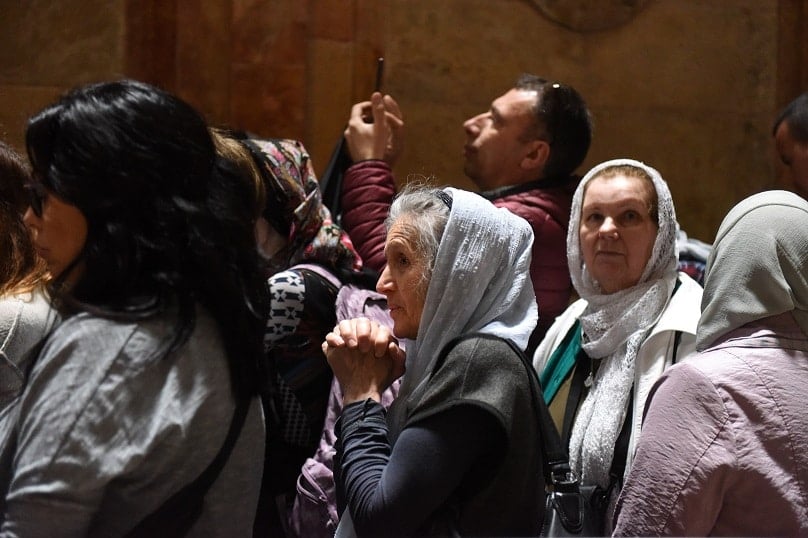
C S Lewis once remarked that the difficulty of giving an explanation for the life, death, and resurrection of Jesus of Nazareth that is not harder than the Christian explanation is very great. That challenge gets exceedingly difficult when it comes to the Resurrection. Alternative explanations to the old Christian story succeed one another with the restless fertility of bewilderment.
• The gospels were written long after the events and the apostles never claimed Jesus rose from the dead.
• Apostles stole the body and lied.
• Apostles cooked up the Resurrection as group therapy
• The women went to the wrong tomb and had hysterics.
• Jesus didn’t die.
• Apostles totally believed it because they all hallucinated the same thing.
• Jesus came back as a ghost.
• Paul cooked up the whole thing and the apostles got shoved out of the picture in favour of the visions of a crazy epileptic. Etc. so on and so forth.
Some people think that merely because so many “alternative facts” are asserted against the gospels this somehow makes it true that the gospels can’t be right. But that is to say “If you throw enough mud, some of it is bound to stick.” The reality is that when the gospels speak as one in saying Jesus is risen and the alternative explanations can’t even agree with each other and often flatly contradict, that suggests that the original story is the true one and the desperate and contradictory stories are junk.
First things first: the gospels were not written long after the events. They and almost all the New Testament documents are written within the lifetime of the apostles or within living memory of them. They have all the earmarks of eyewitness testimony from people who are writing memoirs, not inventing legends. Mark, for instance, is probably separated from the death and Resurrection of Jesus by a smaller span of time than we are separated from the death of John Lennon.
They cite eyewitnesses and, what is more, they cite testimony nobody inventing a fraud would cite. If you are inventing a God Man, you don’t quote him saying he does not know something, but the gospels repeatedly quote Jesus asking questions because he wants information, not because he is speaking rhetorically. They even cite Jesus professing that he does not know when the end of the world will be (Matthew 24:36; Mark 13:32). And they record Jesus crying out “My God, my God, why have you forsaken me?” (Matthew 27:46) while hanging on the Cross, which was taken as absolute confirmation of his rejection by God in the eyes of most of their countrymen since, “Cursed is he who hangs upon a tree” (Deuteronomy 21:23). Only honest people record information that affords their opponents an obvious prima facie case against their central point.
And honest people do not go around stealing bodies and announcing resurrections. Nor do they go out of their way to carefully record their own massive sins, cowardice, betrayals, epic failures and stupidity. But the gospels do all these things. All four carefully record the sins of the apostles, culminating in their utter abandonment of Jesus on Holy Thursday. If the mission of the gospels is to set up the apostles as Jesus’ loyal Right Hand Men, the mission was not accomplished. They don’t even believe the Resurrection. It falls to women who barely figure in the gospel accounts to encounter the Risen Christ first. And not just any women but the band headed by Mary Magdalene “from whom he had cast out seven demons.” (Mark 16:9).

She is, in ancient Mediterranean culture–both Jewish and Greco-Roman–the worst witness in the world for a pack of liars to call as their first witness to the Resurrection, having all the credibility of a UFO abductee in that culture. Indeed, under Jewish law a woman’s testimony was not even admissible in court. So why do the gospels insist on putting her first in the Resurrection narratives? The answer of the Christian tradition is, “Because it’s what actually happened.”
Meanwhile, the obvious claim that the apostles stole the body of Jesus looks weirder and weirder. How do you prove it? If you believe Matthew’s story that a guard was placed at the tomb, then how did the apostles get past them? If you don’t believe Matthew, then who, exactly, is the source of the story that the apostles stole Jesus’ body?
Moreover, what good is this lie to the apostles? What benefit do they derive? Ahead lies nothing but suffering and death for every one of them except John (whose brother James will be among the first murdered). If they are after power, then they are complete idiots.
One variation on the “apostolic lie” theory is that Jesus was supposedly buried, not in a tomb, but in a shallow grave and then eaten by wild dogs. This argument, put forward by John Dominic Crossan on the basis of nothing at all, holds that the apostles somehow turned their frowns upside down and concocted a Resurrection, not as a lie precisely, but as a form of group therapy and then, for some reason, decided to go out into the world to get everybody else to join in their delusion. Along the way, for some reason, they decided it would be a very good idea to invent the story that one of the richest and most prominent members of the Sanhedrin buried Jesus in his family tomb. Because nobody would think to check that or anything anymore than you’d think to check with Bill Gates if somebody said he had offered his family mausoleum to a man who rose from the dead.
Others, seeing the obvious problem with that scenario, attempt to get around that difficulty by shifting the blame for complete idiocy to the women who went to anoint Jesus’ body in the tomb (which now gets to exist again). The story goes that in their befuddlement and grief, they went to the wrong tomb, found it empty and (like you do) immediately concluded Jesus was raised from the dead.
Prescinding from the fact that they had just been to the tomb the day before yesterday and knew the way there, it leaves out other important facts such as the reality that there is more than an empty tomb to contend with: there are also the Resurrection appearances, multiple times under a wide variety of circumstances to nearly five hundred eyewitnesses.
Moving swiftly past this explanation, we then hurry on to the theory that the women went to the right tomb but that Jesus never died on the Cross and only swooned. The claim is that Jesus then woke up in the freezing April tomb, ripped the bandages off the massive wounds he had received in his scourging; staggered to the immense stone on his bleeding and pierced feet, overcame the pain from a spear thrust to his heart, and with hands still in paralysing pain from nails through his wrists, rolled the stone away and lurched gasping into the early dawn to convince his disciples, not that they needed to dial 000 and get him to the emergency room, but that he was the Conqueror of Death, King of Kings, and Lord of Lords.

That preposterous idea tossed aside, the sceptic than moves on to the Hallucination theory, in which up to five hundred people on multiple occasions, all saw the same thing: Christ risen in glory. It’s a theory that is only trotted out on special occasions like “trying to disprove the Resurrection” and nobody believes at any other time, since people never hallucinate the same thing, and when people do hallucinate seeing something they want to see very badly, they do not then fail to recognise what they are desperate to see – which is what happened on three separate occasions with the Risen Christ (John 20:15; Luke 24:16; John 21:4).
Detecting the weakness in that argument, some people propose the spiritualist explanation: the Apostles witnessed a manifestation of Jesus’ ghost from the ectoplasm. This explanation has the advantage of being semi-biblical and would certainly have saved the apostles a lot of grief and hassle were it true. The Apostles were, in fact, prepared to believe in ghosts when Jesus appeared to them on Easter Sunday (Luke 24:37).
If they could have gone out into the world preaching that the ghost of Jesus appeared to them, they would have made many more converts quickly because it’s what human beings expect in such stories. But they were constrained by reality. And the reality was that the Risen Jesus was raised bodily. That’s why the tomb was empty and that’s why many of them touched Jesus and watched him eat. John, constrained by reality and honesty, sums it up this way: the risen Jesus is “that which was from the beginning, which we have heard, which we have seen with our eyes, which we have looked upon and touched with our hands” (1 Jn 1:1).
And so we come to the theory that Paul “invented Christianity” and, after having some kind epileptic seizure on the Damascus Road, transformed a small sect of Jews who just liked to reminisce about their dead rabbi into a weird new sect that turned him into God and announced he was raised from the dead. The problem with this, of course, is the question of why Paul was persecuting them in the first place.
If they were not saying the only thing we have any record of them saying – namely, Jesus Christ is the Son of God and was crucified and raised from the dead – then why was he bothering to go to Damascus to jail them? Moreover, if Paul cooked it all up, how did he persuade the twelve Apostles to decide that the guy they had lived with for three years was not just a dead friend whose memory they cherished, but was the God of Israel and raised from the dead? Why would they listen to this crazy rabbi and his story of a vision on the Damascus Road when they knew perfectly well that Jesus was dead and buried? And why would Paul, in turn, concoct a yarn about Jesus appearing “to Cephas, then to the Twelve. Then he appeared to more than five hundred brethren at one time, most of whom are still alive, though some have fallen asleep. Then he appeared to James, then to all the apostles” (1 Co 15:5–7)?
The answer is simple: Paul didn’t invent Christianity. He received his catechesis on the Resurrection appearances from the Twelve and the tradition they taught the Church after his johnny-come-lately encounter with the Risen Christ, then spent several years learning, not inventing, the teaching of Jesus they handed down.
That’s why Paul, like the Twelve, went rejoicing to his death for Christ: they knew Christ is risen and so they knew they had nothing to fear from death anymore.
